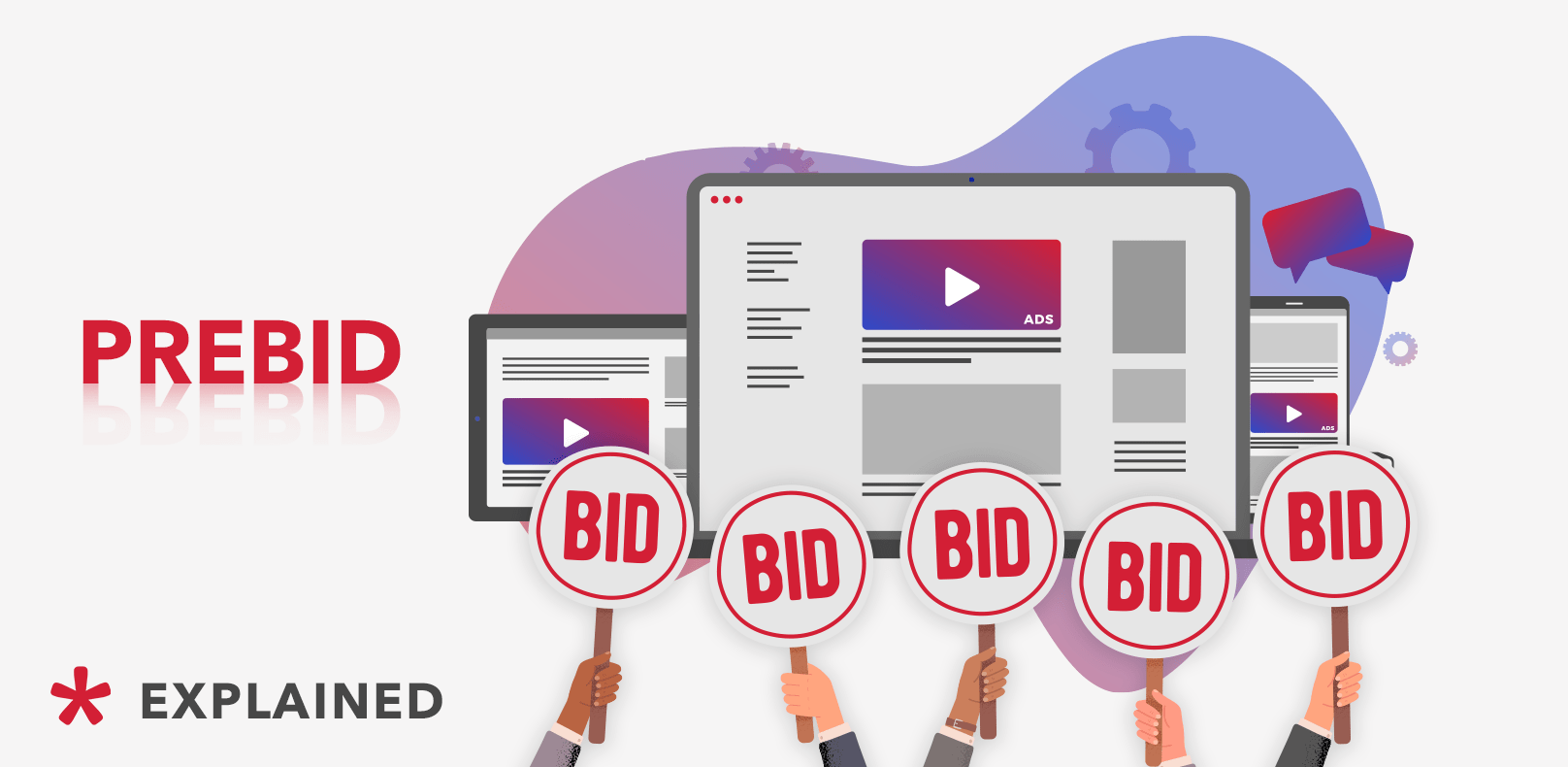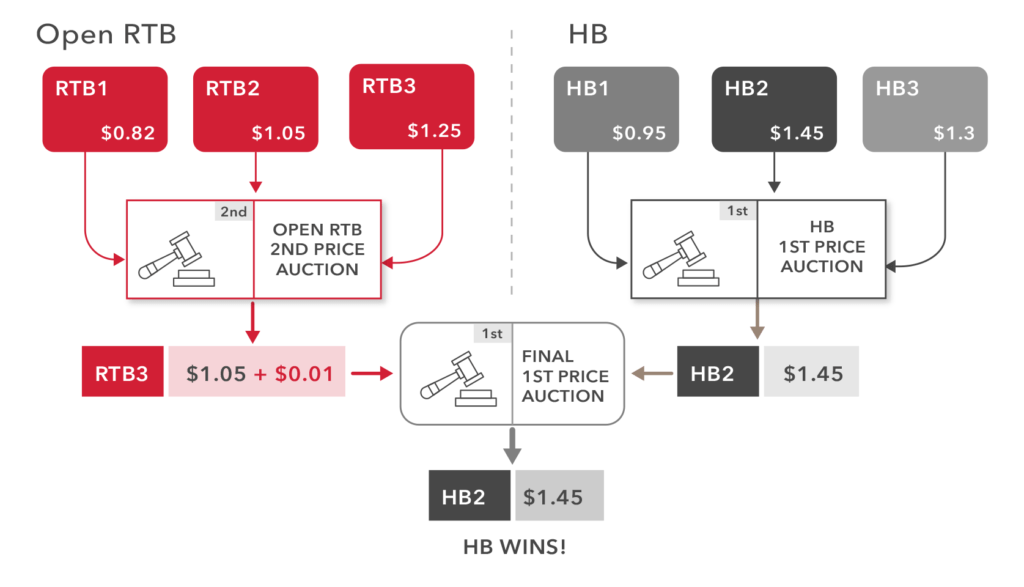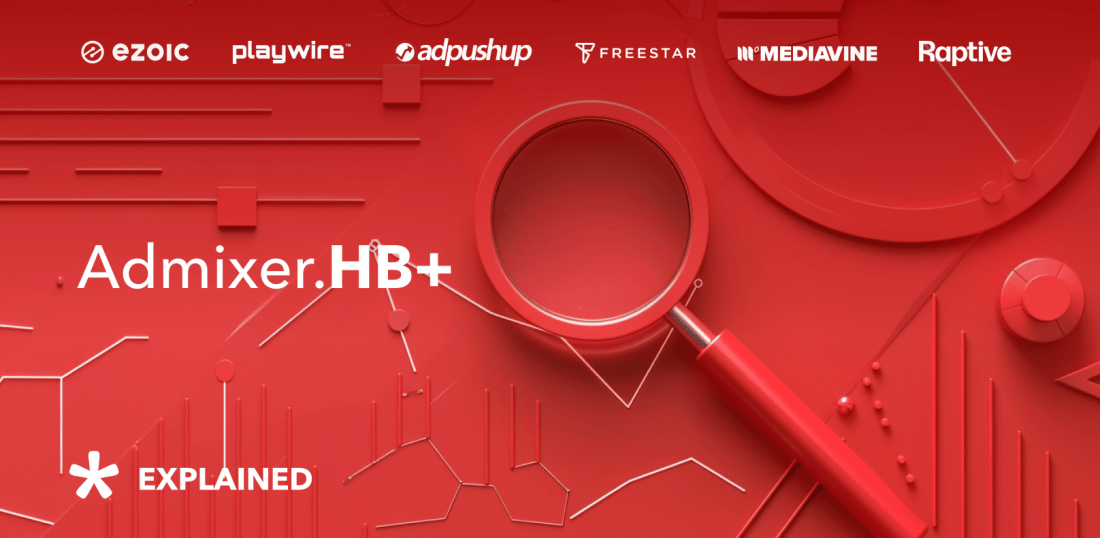
Prebid: The Technology Behind Header Bidding
Header bidding made a revolution in the advertising market and permitted media owners to boost their revenues by diversifying demand. However, during the early stages of adoption, header bidding was plagued with low standards, fragmented solutions, and almost no collaboration between providers.
Everything changed with the launch of Prebid.js in 2015, which introduced a straight-forward industry-standard, simplified the setup, and speeded up the technology’s adoption.
Even though header bidding demonstrated its efficiency in increasing yield for media owners, a third of U.S. publishers had not used it in Q3 2020. Despite the countless benefits, even the Prebid solution is not that easy to deploy on the website or app. Let’s review why this technology is so disruptive and how you can introduce it to your media business.
- What is header bidding?
- How does header bidding work?
- oRTB vs. Header Bidding
- What is Prebid.js?
- How Prebid.js was invented?
- What is Prebid server?
- What is Prebid mobile?
- Benefits of using Prebid
- How hard it is to implement Prebid.js
- Main Issues with Prebid implementation
- Line items
- API
- Real-time statistic and analytics
- Prebid vs. Admixer.Network bidding solution
- To wrap up
What is header bidding?
Header bidding became the next logical step in the development of the adtech ecosystem. Compared to oRTB, which conducts several consecutive auctions, header bidding lets all players enter the auction at the same time.
Header bidding is an adtech tool that allows publishers to offer their impressions to many platforms and advertisers who use them. Header bidding removes the veil of ignorance between advertisers and publishers about the market price of the inventory. It allows publishers to access different markets, connect new demand partners and boost their inventory price.
In header bidding auctions, all Demand Side Platforms (DSPs) have equal access to auction and compete for the price instead of entering the auction one-by-one.
We’ve previously explained what motivated publishers to use header bidding.
How does header bidding work?
The header bidding connection is deployed with a JavaScript wrapper, installed into the header of the webpage.
The wrapper is a container of tags. In the ad tag case, you would assign an ad space to a distinct advertiser or call demand partners one after the other, but not with the header wrapper, where all parties get instant connection to the auction.
A technology of the wrapper streamlines the management of the demand partners for publishers. By merely adding bidder identifiers to the container, publishers can quickly plug in more interested parties into the negotiations.
oRTB vs. Header Bidding
The programmatic ecosystem was born with the introduction of oRTB, which significantly boosted the speed and the efficiency of ad serving. This technology fundamentally changed media buying mechanics and allowed advertisers to bid for individual impressions in real-time instead of purchasing blocks of ads. oRTB allowed publishers to get a real market value for the impressions, and instead of selling in bulk, they can get a better price for audience segments that are in demand right now.
Even though oRTB ensured a higher yield than waterfall, it still had problems of its own. At the core, oRTB is a series of auctions, which frequently didn’t provide the highest available CPM, and couldn’t guarantee appropriate fill rates.
The market fragmentation and the number of ad tech vendors were growing, and publishers had to constantly test different adtech platforms with cumbersome integrations to negotiate a fair price for their inventory. The invention of header bidding allowed us to put this matter to rest and concentrate on what really matters — the content and brand loyalty of their customer base.
Admixer created a hybrid auction that allows getting the best of both worlds by conducting a final auction between the winners of oRTB and Hybrid Programmatic.
Here’s how it works:

What is Prebid.js?
Prebid.js is an open-source solution that allows publishers to quickly implement header bidding on websites and mobile apps. Publishers previously had to recruit a full-scale tech team to set up header bidding, and it’s a lot easier with Prebid.
Prebid created an environment for the mass adoption of header bidding by setting up an open tech layer upon which other ad tech vendors can add their code and build a native solution.
Prebid.js provides the most extensive library of efficient adapters to connect publishers to the major advertising platforms. Currently, Prebid.js is the most popular header bidding wrapper on the web.
How Prebid.js was invented?
The most significant player in the programmatic marketplace is Google Ad Manager (GAM), previously known as Doubleclick for Publishers. It is a go-to platform for publishers seeking monetization with ads, a default choice for many media businesses. Due to its scale, GAM can provide one of the best fill rates in the industry. Yet, GAM provides limited insight into its algorithms and never discloses information about the bid rates. As a result, publishers who rely on GAM frequently got lower CPMs that they would get elsewhere.
To combat this market fragmentation, AppNexus came up with a disruptive tech tool called Prebid.js. Prebid.js is a custom wrapper that allows media owners to deploy header bidding and get a better price for their ad spaces while not breaking the ties with the GAM.
This header bidding platform allows publishers to gather bids from the external demand platforms before the ad call is sent to their GAM ad server. In case GAM couldn’t outbid the price, the ad slot goes to the highest-paying external demand partner.
This way, publishers preserve the perk of GAM – exceptional fill rates while getting a higher price for their ad slots with HB.
In such a way, publishers can get a better yield for their placement and better fill rates with HB.
According to the Admixer case study, for publishers who implement header bidding on top of the GAM integration, the price of impression increases by 70% on average.
What is Prebid server?
Prebid.js is running in the user’s browser on the client-side, which have significant drawbacks such as page latency. With Prebid server, header bidding is performed on the dedicated server, which removes the strain from the browsers, speeds up the ad serving, and gives users a better content experience.
The Prebid server supports all the major ad environments:
- web
- in-app
- AMP
- long-form video
What is Prebid mobile?
Prebid was widely successful in automating and speeding up header bidding on the web, and a few years later, AppNexus developed the solution for the mobile environment.
Prebid mobile is a light-weight open-source SDK. It was launched to address common challenges when deploying header bidding for mobile apps. Prebid mobile simplified the integrations with mobile demand partners, reducing the pressure on ad ops teams, and significantly cutting down page latency.
Benefits of using Prebid
Prebid is a free technology that you can implement on your website or app, or build a custom solution on top of it, or choose one of the Prebid-based solutions of other adtech vendors.
Regardless of your decision, deploying header bidding with Prebid have countless benefits for publishers:
- Prebid reduces page latency compared to waterfall provides a better content experience. Due to the asynchronous setup, ad creatives’ potential issues do not influence the page’s load, allowing them to deliver content faster.
- The largest library of header bidding adapters allows seamless integration of the wide variety of bidders from across the globe for a truly demand-based price.
- Prebid allows you to work with all possible ad formats on both mobile and desktop devices.
| Display | Native | Outsteam video | Instream video | |
| Web | ✔ | ✔ | ✔ | ✔ |
| Accelerated Mobile Pages (AMP) | ✔ | ✔ | ✔ | ✖ |
| Mobile Applications | ✔ | ✔ | ✔ | In Development |
| Connected TV/OTT | N/A | N/A | N/A | N/A |
How hard it is to implement Prebid.js
Despite the fact that Prebid immensely simplified the header bidding process and made it much easier to implement, it is still a challenge for many. The majority of publishers don’t grasp the principles of header bidding, let alone the sophisticated deployment.
Implementing Prebid on your platform requires:
- development resources,
- an experienced ad ops,
- setting up line items in the Google Ad Manager,
- signing agreements with bidders, etc.
Setting up header bidding action requires a dedicated team, time, and effort, which is not always the case even for large-sized publishers.
Sometimes, implementing header bidding with Prebid, with all the manual integrations, does not pay off due to the high entry costs for media owners. However, there are already solutions on the market that take care of all the redundant procedures and setups and won’t burden the media buying.
Main Issues with Prebid implementation
Line items
As mentioned before, the prevalent form of header bidding on the market is the prebid.js technology and ad servers from Google (Google Ad Manager, previously known as Doubleclick for Publishers). The main roadblock for effective work with Google’s ad server is setting up line items.
Line item – contains the information on how to place a creative on website or app, and other essential ad serving information.
The most straightforward way is to set up a line time manually. However, this is a very redundant and menial task. As a rule, you need to create up to 400 of such line items and tie them to the creatives. Any mistakes in the set up of line items can cause significant discrepancies and ultimately lost revenue.
API
To streamline the procedure of setting up line items, Google introduced its API, allowing to create all the necessary entities in an automatic fashion. However, using this technology requires solid coding skills.
Fortunately, there are many turn-key solutions where you do not need to write the code yourself; just download and run the CLI. Instead of complex procedures, you do some manipulation with Google Ad Manager and enter the necessary data in the CLI – all the API integrations will happen automatically .
However, this option is also quite difficult for most customers, as everything has to be entered in the command line, which is not very user-friendly and often counterintuitive.
Real-time statistic and analytics
Gathering and analyzing statistics can be quite challenging with Prebid.js. It is an open auction, and you need to have relevant data on the bid rates, time outs, yield, and fill rate. This information is vital to timely identify problems with the demand partners and safeguard ad revenues.
However, it can be a very technically demanding task since you need to create a system compatible with all of the adapters. Ideally, it should display all the available data in a comfortable UI interface.
Collecting and analyzing statistics can be quite an uphill battle; as prebid.js is an open auction, you can implement your service to collect all the necessary statistics for analysis. This is necessary for the timely detection of problems with the demand partners. It is quite difficult to manage it in-house, but there are already solutions that can provide such functionality.
Prebid vs. Admixer.Network bidding solution
Prebid.js is a disruptive technology that forever altered the adtech landscape. However, because it is an open-source technology, it provides only core features.
It is basically a DIY kit for publishers.
Admixer.HB+ header bidding platform goes above and beyond the Prebid’s basic functionality and adds some really useful features. “
Admixer will allow publishers to boost their revenue with HB while saving on the development resources and ad ops team by managing all the bidders in the intuitive interface.
Below you can contrast and compare Prebid.js and all the additional features of Admixer:
| Prebid | Admixer | |
| Header bidding | ✔ | ✔ |
| Video header bidding | requires custom work and implementation | ✔ |
| Easy set up (without installation of js code on the website) | ✔ | |
| Intuitive UI (dashboard for adding demand partners, customizing ad spaces) | ✔ | |
| Integration with Google Ad Manager API (create line items in few clicks) | ✔ | |
| Ability to connect without Google account | ✔ |
To wrap up
At Admixer, we have years of ad optimization behind our backs, which allowed us to develop our proprietary header wrapper, which is easy to set up, manage and connect to all the major demand platforms.
Admixer takes care of the redundant task of HB, like deploying the code, setting up the line items, establishing connections with bidders. Instead, it allows publishers to focus on what really matters, like growing their customer base, boosting engagement and loyalty etc.
Admixer takes care of the HB implementation for a fraction of what it would cost to do in-house with the development team.




